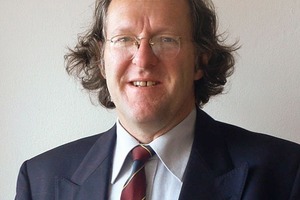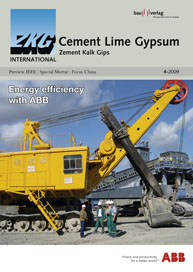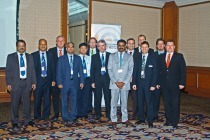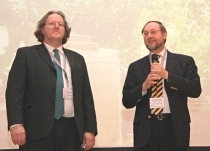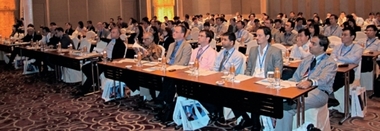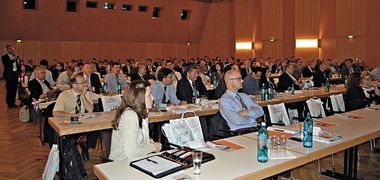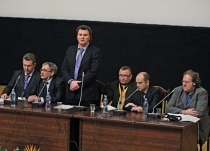Improving the standardization
5th China Exhibition of Mortar Technology & Products, Beijing/China (04.–07.03.2009)As part of the China Build + Deco Fair 2009, the 5th China Exhibition of Mortar Technology & Products took place from 04.-07.03.2009 at the Beijing New International Exhibition Halls near Capital Airport. The China Build + Deco Fair 2009 featured over 6000 booths on more than 100 000 m2. The China Dry Mix Mortar Association (affiliated with CBMC) had organized a drymix mortar pavilion with over 60 participating exhibitors. Visitors from throughout Asia attended the event and the conference in order to exchange their ideas concerning the further growth and promotion of drymix mortar technology in China. Ferdinand Leopolder of drymix.info also attended and contributed to the lecture programme. Ted Wang (Fig. 1), a consultant with Marcchem (a German – Chinese enterprise) who had previously worked for Wacker and Maxit interviewed Ferdinand Leopolder for ZKG INTERNATIONAL about the outcome of the conference.
Ted Wang: What motivated you to attend this conference?
Ferdinand Leopolder: When seen globally, the drymix mortar industry was pretty much a European affair in the last century. Of course some interesting remote markets existed, but by no means did those regions reach the volumes and sophistication of any western European market such as Germany, France, Italy, Austria, Scandinavia. This changed entirely when China came into focus in the early 2000s. Last year, Chinese drymix mortar production surpassed that of Germany, the largest market at that time. If the projections are correct, China will produce over 50 % of the world volume for drymix mortar by 2012. In view of this, I did not need any convincing to participate at this event, which is the largest of its kind in Northern China.
Ted Wang: How would you describe the attendance?
Ferdinand Leopolder: I had vivid personal discussions with many drymix mortar experts from China, this not only included representatives from mortar Research & Development and product development, but I also met many of the relevant players in the supply industry. Several initiatives such as the Technical Committee for Tiling, TCT, also made presentations and made themselves available for questions. The drymix mortar pavilion was also well attended.
Ted Wang: Which additional programme features took place during the show?
Ferdinand Leopolder: Apart from the conference, which ran for two days (about 20 lectures on various mortar topics), I found the very practical approach of TCT with a large booth in the drymix mortar pavilion most interesting. They chose to combine real hands-on product demonstrations with another most comprehensive series of lectures right inside the exhibition. Special information material was prepared for the visitors to introduce the general drymix mortar idea as well as sophisticated tile adhesives and grouts in particular. Contributors included the complete “who’s who” of specialty mortars such as Ardex, BASF, C-Cure (license for custom building products), Laticrete, Mapei and Weber Maxit.
Ted Wang: What are the “hot topics” in China today?
Ferdinand Leopolder: I had a chance for discussions with Mr. Zheng Quan, President of the China Drymix Mortar Council CBMC and in their predictions, the so-called skim coats (in China: “wall putties”) will play the most important role in the future. These are very thin mortar applications as a stable base for painting, both exterior and interior. In this segment alone, the council expects double-digit growth rates over the next few years. In terms of specialty mortars, the major topic is thermal insulation of course. As a country poor in primary energies, China has realized its responsibility to save resources and has taken considerable steps to improve the thermal protection of existing and future buildings. However, there are still serious quality issues concerning installed EIFS systems. Legislators are currently working on improving the standardization issues concerning topics such as the problematic XPS boards, specifying non-flammable EPS with proper strength and issuing binding specifications for reinforcement mesh and mortars. The main issue to be addressed is the workmanship, and multiple activities of the industry, led by Baumit China, are under way to create a curriculum for EIFS installers. In conjunction with Shanghai Tongji University, supported by the European Community, a competence center has been established near the Tongji campus.
Ted Wang: How do you see the future of drymix mortars in China?
Ferdinand Leopolder: There is no doubt that China will continue its drymix mortar success story in the years to come. If and how the global recession will impact this development cannot be judged at this point in time, however, it seems sure that the bundle of legislative measures (e. g. forcing of thermal insulation, ban of jobsite mixes) will have its impact now. However, some changes are
essential for the success of drymix mortars: First of all, China needs to adapt and implement the system character of EIFS (if one part fails the entire system fails!) and secondly China will need to initiate qualification certificates and training for their totally untrained workforce. The current recession, where millions of migrant workers have already been sent back to their home towns, might present the opportunity to do so immediately. These workers could then return as specialists when business picks up again.
Ted Wang: Thank you very much for this interview.

